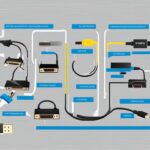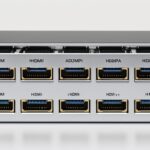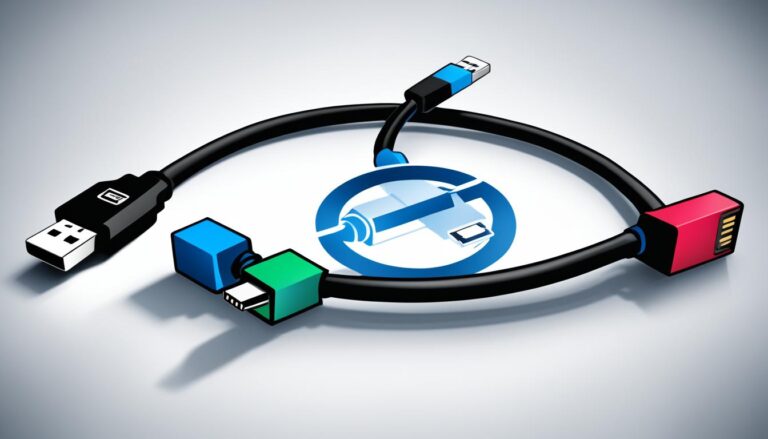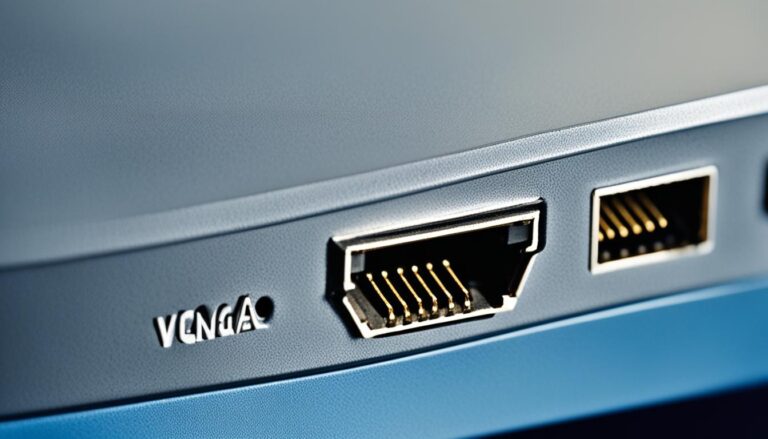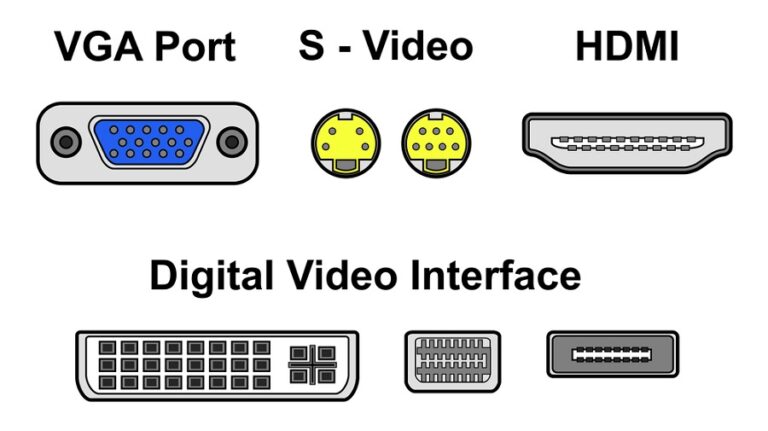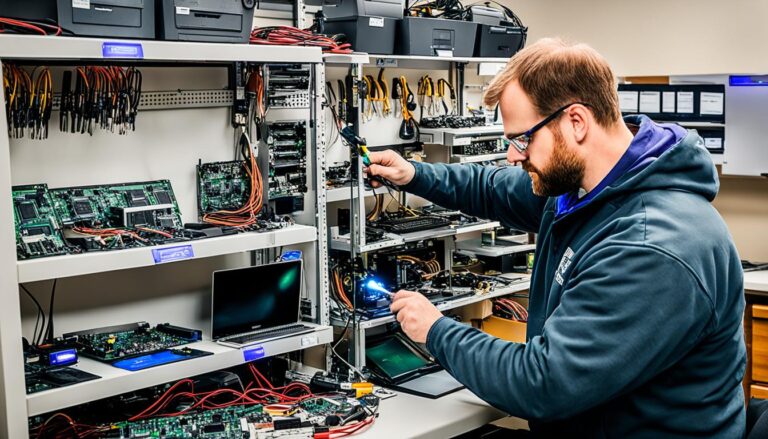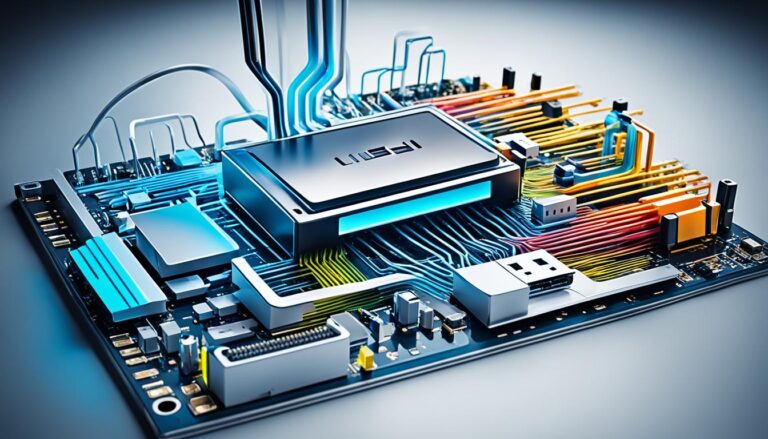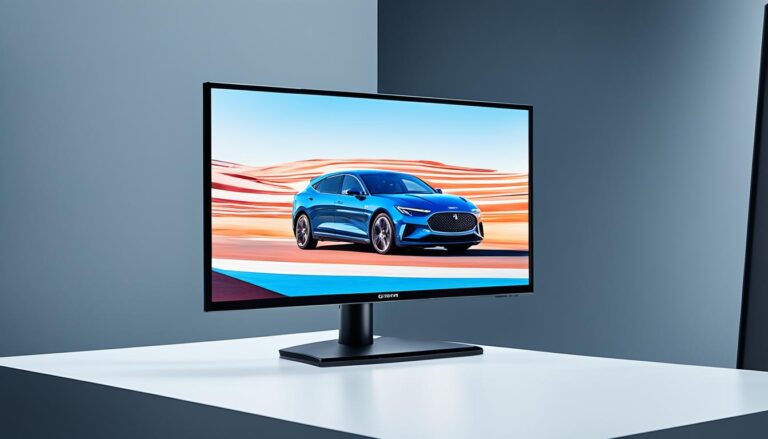Many are eager to know which port is the quickest. We’re going to look into different ports’ speeds. We’ll find out which one is the fastest.
Choosing the right port is vital for good network speed. It matters for both home networks and big enterprise setups. Knowing about port speeds helps improve network performance.
We’ll compare different ports to help you make a good choice. The aim is to ensure smooth data flow, lower delays, and better connectivity. This affects gaming, streaming, and work operations greatly.
Next, we’ll get into details about Fast Ethernet and Gigabit Ethernet. We’ll discuss their differences, uses, and setup needs. By the end, you’ll know which port suits your network best.
Understanding Fast Ethernet and Gigabit Ethernet
Fast Ethernet and Gigabit Ethernet serve as two key Ethernet types. Each type has its unique specifications and requirements. Knowing their differences is crucial to choose the right option for your network.
Fast Ethernet has a speed of 100 Mbps. It’s great for different applications and is common in small to medium networks. It’s a budget-friendly choice for businesses not needing very high speeds.
Gigabit Ethernet is much faster, offering speeds of 1000 Mbps. This is ten times faster than Fast Ethernet. It’s perfect for networks needing quick data transfer, like big file sharing, streaming, and intensive applications.
Choosing between Fast Ethernet and Gigabit Ethernet involves looking at your network’s needs. If speed and high data transfer are crucial, go for Gigabit Ethernet. But, if you have lower bandwidth needs and are watching costs, Fast Ethernet could be enough.
Fast Ethernet runs at 100 Mbps, whereas Gigabit Ethernet speeds up to 1000 Mbps. This makes Gigabit Ethernet 10 times faster than Fast Ethernet.
Table: Comparison of Fast Ethernet and Gigabit Ethernet
| Features | Fast Ethernet | Gigabit Ethernet |
|---|---|---|
| Transmission Speed | 100 Mbps | 1000 Mbps |
| Use Cases | Good for small to mid networks with moderate needs | Best for networks needing fast data transfer and demanding apps |
| Cost | A cost-effective pick | More expensive due to its speed boost |
| Compatibility | Works with normal Ethernet cables | Needs special cables and switches |
Compatibility and Upgradability
Fast Ethernet and Gigabit Ethernet use standard cables. But, Gigabit Ethernet needs special cables and switches for its speed. This raises the cost when upgrading to a Gigabit Ethernet network.
Also, moving from Fast Ethernet to Gigabit Ethernet might mean spending more on new infrastructure and gear. Think about compatibility and how easy it is to upgrade before choosing the right Ethernet type for your network.
The Differences Between Fast Ethernet and Gigabit Ethernet
When we compare Fast Ethernet and Gigabit Ethernet, we see several key differences. These differences can greatly affect network performance and connectivity. It’s important to know these differences to choose the right Ethernet for your needs.
The biggest difference is in speed. Gigabit Ethernet is much faster than Fast Ethernet, offering a speed of 1000 Mbps. This is ten times the 100 Mbps speed of Fast Ethernet. Because of this, Gigabit Ethernet is better for high-speed data transfer and achieving exceptional network performance.
Gigabit Ethernet also has a shorter delay in data travel, which enables a quicker response. This is very useful for things like video streaming and online gaming. Small delays can make a big difference in these areas.
Furthermore, Gigabit Ethernet needs special cables and switches to handle its high speeds. This hardware makes sure the network can carry more data and avoid bottlenecks.
Fast Ethernet, however, uses standard cables and switches. This makes it a cheaper and more available option for situations where high speed isn’t as important.
Switching to Gigabit Ethernet comes with some challenges and costs. You might need to change your current network setup. This includes switches and cables to support more data. Organizations should think carefully about their network needs and the cost benefits of upgrading.
Comparison Table: Fast Ethernet vs. Gigabit Ethernet
| Comparison Factor | Fast Ethernet | Gigabit Ethernet |
|---|---|---|
| Speed | 100 Mbps | 1000 Mbps |
| Round-Trip Delay | Longer | Shorter |
| Cable and Switch Requirements | Standard | Specialized |
| Upgrade Complexity | Less complex | More complex |
The table above provides a quick, detailed comparison of Fast Ethernet and Gigabit Ethernet. It highlights their main differences.
By looking at the differences between Fast Ethernet and Gigabit Ethernet, organizations can choose the right Ethernet. This decision will depend on their network needs, budget, and future plans.
Factors to Consider When Choosing Ethernet Speed
When you’re choosing between Fast Ethernet and Gigabit Ethernet, think about what you need. If you need very fast Internet and LAN speeds, go for Gigabit Ethernet. But if your needs don’t go beyond 100 Mbps, Fast Ethernet could be enough for you.
Coverage also matters a lot in this decision. Fast Ethernet works well for distances up to 10 km. But if you need to reach further, up to 70 km, you’ll need Gigabit Ethernet.
Don’t forget about the devices you’ll use. Both Fast and Gigabit Ethernet use similar devices. But, Gigabit Ethernet needs special cables and switches, which might cost more.
Think about setting things up and future upgrades too. Setting up Gigabit Ethernet can be more complex. Moving from Fast Ethernet to Gigabit Ethernet also involves more steps and costs.
In summary, decide based on what speed your tasks need. Also, think about how far the connection has to reach, what devices you’ll need, and how complex setup and upgrades will be. This will help you make the best choice for your network.
Factors to Consider:
- Required speed for your applications
- Coverage distance
- Device requirements
- Configuration complexities
- Upgrading considerations
Coverage and Device Requirements of Fast Ethernet and Gigabit Ethernet
Looking at Fast Ethernet and Gigabit Ethernet, we must grasp their strengths and limits. Let’s dive deeper into these points.
1. Coverage
Fast Ethernet can cover up to 10 km. It’s perfect for small networks or LANs in buildings or campuses.
Gigabit Ethernet, however, stretches up to 70 km. This makes it great for big networks and WANs across several places.
In summary:
| Ethernet Type | Coverage |
|---|---|
| Fast Ethernet | Up to 10 km |
| Gigabit Ethernet | Up to 70 km |
2. Device Requirements
Fast Ethernet and Gigabit Ethernet need similar tools like NICs and switches. Yet, Gigabit Ethernet needs special cables and switches for its speed.
Choosing these special tools raises the cost for Gigabit Ethernet. Keep this in mind when planning your network’s budget.
To summarize:
| Ethernet Type | Device Requirements |
|---|---|
| Fast Ethernet | Standard cables and switches |
| Gigabit Ethernet | Specifically designed cables and switches |
In summary, knowing the coverage and device needs of Fast Ethernet and Gigabit Ethernet helps pick the best for your network. Fast Ethernet suits smaller networks with a 10 km range. Gigabit Ethernet fits larger networks with up to 70 km coverage. But, remember Gigabit Ethernet’s special cables and switches add to costs.
Configuration and Upgrades of Fast Ethernet and Gigabit Ethernet
When you’re looking to upgrade your network, knowing how Fast Ethernet differs from Gigabit Ethernet is key. Both provide reliable connections, but there are key factors to consider.
Configuration:
Setting up Fast Ethernet is pretty simple and doesn’t need much effort. It works at a speed of 100 Mbps. This speed is good for smaller or medium networks. It uses typical Ethernet cables and doesn’t require special equipment.
Gigabit Ethernet, however, involves a more detailed setup due to its 1000 Mbps speed. For the best performance, you need specific devices and switches made for Gigabit Ethernet. These help make sure everything works well together and improves your network.
Upgrades:
Switching to Gigabit Ethernet from Fast Ethernet boosts your network’s speed and how it performs. But, it’s important to weigh the needed investments and the complexity of this upgrade.
Moving smoothly to Gigabit Ethernet involves:
- Switching out old Fast Ethernet switches for Gigabit ones.
- Checking if your tech, like PCs and servers, can use Gigabit Ethernet.
- Needing Cat5e or better Ethernet cables for top performance.
- Adjusting your network settings for Gigabit Ethernet and connecting without issues.
Even though upgrading takes more effort, the faster speeds and better network response are worth it.
By carefully planning your network’s configuration and upgrades for both Fast and Gigabit Ethernet, you can make it more effective.
| Fast Ethernet | Gigabit Ethernet | |
|---|---|---|
| Speed | 100 Mbps | 1000 Mbps |
| Cables | Standard Ethernet cables | Cat5e or higher-rated Ethernet cables |
| Devices | Standard Ethernet devices | Specific devices for Gigabit Ethernet |
| Configuration | Straightforward | More complex, requires specific devices and switches |
Table: A comparison of Fast Ethernet and Gigabit Ethernet.
Quality Ethernet Switches from VERSITRON
To get the best network performance, choosing quality Ethernet switches is vital. VERSITRON offers top-notch managed switches. They come with various port options to fit your needs. These switches support both Fast Ethernet and Gigabit Ethernet connections well.
VERSITRON’s quality Ethernet switches guarantee efficient and dependable network operations. These switches feature cutting-edge technology. They also use durable components for stable, high-speed data transmission.
The range of managed switches by VERSITRON lets you build a network that suits your specific requirements. VERSITRON provides options for both large and small networks. This includes switches with many ports or compact ones for tighter spaces.
Choosing quality Ethernet switches means better network security. VERSITRON’s products include advanced safety features. These include VLAN support and access controls. They keep your data safe from unauthorized intrusions and breaches.
VERSITRON’s switches work well with various networking devices and standards. Their compatibility helps integrate them into your existing network smoothly. This prevents any issues with compatibility and ensures a steady flow of data.
The Benefits of VERSITRON’s Quality Ethernet Switches:
- Reliable and efficient network operations
- Advanced technology and robust components
- Flexible configurations to suit your needs
- Enhanced network security with advanced features
- Excellent compatibility with different networking devices and protocols
Customer Testimonial:
“We have been using VERSITRON’s quality Ethernet switches for our network, and we’re very pleased. The switches are simple to set up and ensure smooth connectivity. Highly recommended!”
Buying VERSITRON’s Ethernet switches keeps your network strong, reliable, and secure. VERSITRON offers a wide selection and the latest features, making them a leading provider.
Conclusion
In conclusion, choosing the quickest port depends on your app’s speed needs and other factors. These include coverage, device needs, setup, and updates.
Fast Ethernet works well for apps needing up to 100 Mbps. On the other hand, Gigabit Ethernet provides high Internet and LAN speeds.
Picking between Fast Ethernet and Gigabit Ethernet is key for the best network performance and connectivity.
FAQ
Which type of Ethernet is faster: Fast Ethernet or Gigabit Ethernet?
Gigabit Ethernet is quicker, offering speeds up to 1000 Mbps. Fast Ethernet reaches up to 100 Mbps.
What are the main differences between Fast Ethernet and Gigabit Ethernet?
Fast and Gigabit Ethernet vary in speed, time taken for a signal to travel, and what equipment they need. They also differ in how complex they are to set up and update.
What factors should I consider when choosing between Fast Ethernet and Gigabit Ethernet?
Think about what speed you need and how far the network extends. Consider what your devices need. Also, think about how hard it will be to set up and if you might upgrade later.
What is the coverage distance for Fast Ethernet and Gigabit Ethernet?
Fast Ethernet reaches up to 10 km. Gigabit Ethernet goes further, up to 70 km.
What are the device requirements for Fast Ethernet and Gigabit Ethernet?
Both need similar devices. Gigabit Ethernet, though, requires special cables and switches. This could mean higher costs.
Is the configuration of Gigabit Ethernet more complex than Fast Ethernet?
Yes, Gigabit Ethernet’s setup is more intricate because of its specific device needs. Moving from Fast to Gigabit Ethernet also means a bigger investment and more complexity.
What role do quality Ethernet switches play in network performance?
Good Ethernet switches are vital for top network performance. VERSITRON provides switches that support both Ethernet types. These have various port options to fit your needs.








